信息工程专业英语课程论文
- 格式:doc
- 大小:2.36 MB
- 文档页数:8
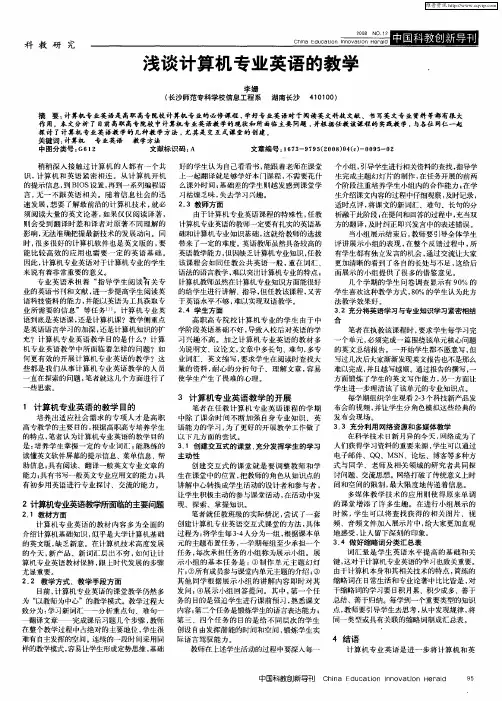
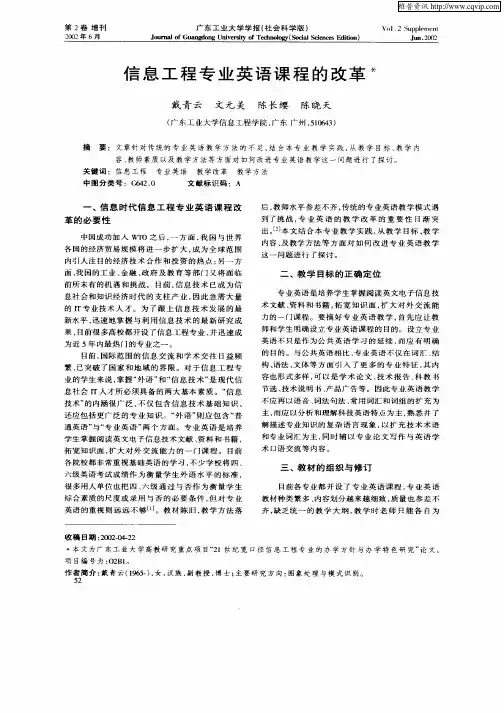
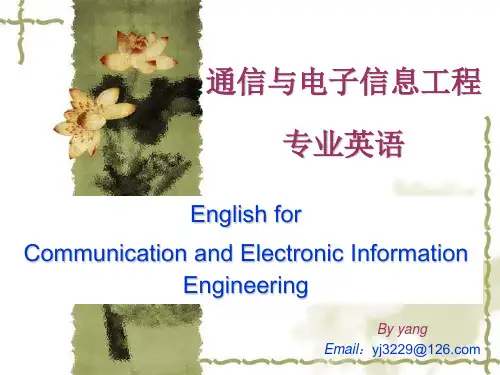
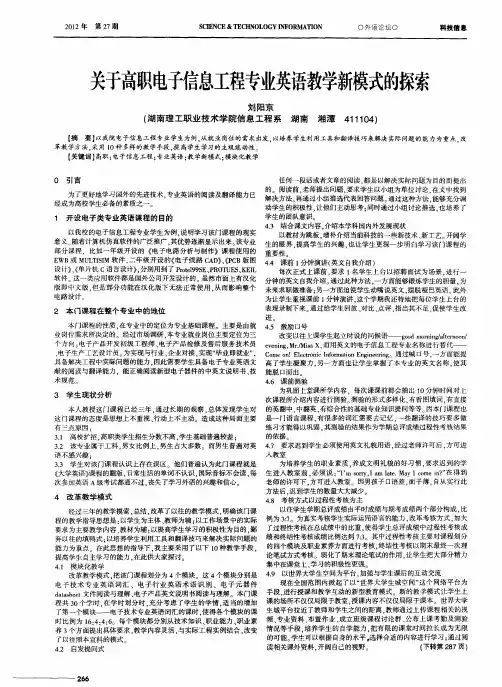

本文的着重介绍了运算放大器。
Harry Black为解决放大器的增益稳定性而提出负反馈的概念到早期运算放大器在模拟计算器中的巨大作用,晶体管的出现大大减小了运算放大器的体积,集成运放在模拟应用中有着巨大的作用。
可靠稳定。
关键词:运算放大器、负反馈、晶体管、集成运放
The article focuses on the operational amplifiers. In this paper, we canfind that the op amps was born on the daywhen Harry Black put forward the concept of negative feedbackin order to solve the problem of the gain’s instability.It played a great role in the early phase’s development of the analog computer, which became popular until the emergence of the transistor. The IC op amps showed up as soon as the transistor greatly reduced the volume of operational amplifiers. To this day, the op amp still has a strong vitality in the areas of analog design.
Key words:
op ampstransistornegative feedback analog circuitry。
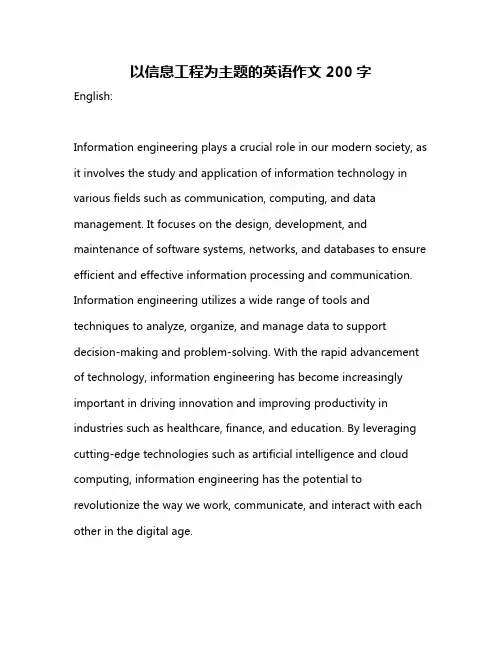
以信息工程为主题的英语作文200字English:Information engineering plays a crucial role in our modern society, as it involves the study and application of information technology in various fields such as communication, computing, and data management. It focuses on the design, development, and maintenance of software systems, networks, and databases to ensure efficient and effective information processing and communication. Information engineering utilizes a wide range of tools and techniques to analyze, organize, and manage data to support decision-making and problem-solving. With the rapid advancement of technology, information engineering has become increasingly important in driving innovation and improving productivity in industries such as healthcare, finance, and education. By leveraging cutting-edge technologies such as artificial intelligence and cloud computing, information engineering has the potential to revolutionize the way we work, communicate, and interact with each other in the digital age.Translated content:信息工程在我们现代社会中发挥着至关重要的作用,它涉及在通信、计算和数据管理等各个领域应用信息技术的研究和应用。
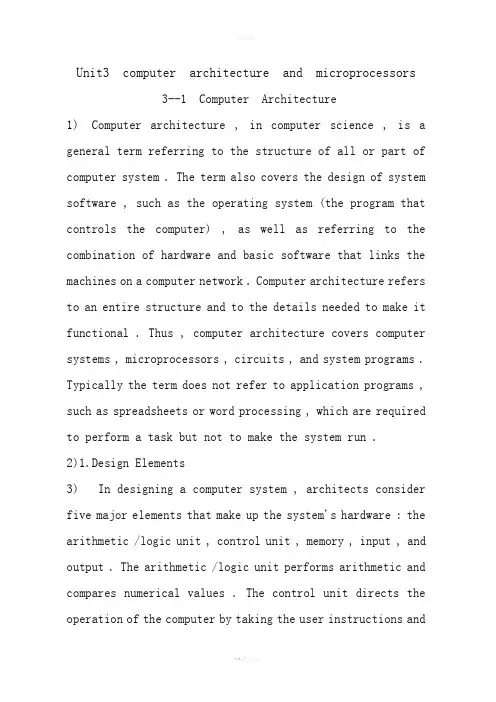
Unit3 computer architecture and microprocessors3--1 Computer Architecture1) Computer architecture , in computer science , is a general term referring to the structure of all or part of computer system . The term also covers the design of system software , such as the operating system (the program that controls the computer) , as well as referring to the combination of hardware and basic software that links the machines on a computer network . Computer architecture refers to an entire structure and to the details needed to make it functional . Thus , computer architecture covers computer systems , microprocessors , circuits , and system programs . Typically the term does not refer to application programs , such as spreadsheets or word processing , which are required to perform a task but not to make the system run .2)1.Design Elements3) In designing a computer system , architects consider five major elements that make up the system's hardware : the arithmetic /logic unit , control unit , memory , input , and output . The arithmetic /logic unit performs arithmetic and compares numerical values . The control unit directs the operation of the computer by taking the user instructions andtransforming them into electrical signals that the computer 's circuitry can understand . The combination of the arithmetic /logic unit and the control unit is called the central processing unit (CPU) . The memory stores instructions and data . The input input and output sections allow the computer to receive and send data , respectively .4) Different hardware architectures are required because of the specialized needs of systems and users . One user may need a system to display graphics extremely fast , while another system may have to be optimized for searching a database or conserving battery power in a laptop computer .5) In addition to the hardware design , the architects must consider what software programs will operate the system . Software , such as programming languages and operating systems , makes the details of the hardware architecture invisible to the user . For example , computers that use the C programming language or a UNIT operating system may appear the same from the user's viewpoint , although they use different hardware architectures .6)2.Processing Architecture7) When a computer carries out an instruction , it proceeds through five steps . First ,the control unit retrieves theinstruction from memory , for example , an instruction to add two numbers . Second , the control unit decodes the instruction into electronic signals that control the computer . Third , the control unit fetches the data (the two numbers) . Fourth , the arithmetic/logic unit performs the specific operation ( the addition of the two numbers ) . Fifth , the control unit saves the result ( the sum of the two numbers ) .8) Early computers used only simple instructions because the cost of electronic capable of carrying out complex instructions was high . As this cost decreased in the 1960s , more complicated instructions became possible . Complex instructions ( single instructions that specify multiple operations ) can save time because they make it unnecessary for the computer to retrieve additional instructions . For example , if seven operations are combined in one instruction , then six of the steps that fetch instructions are eliminated and the computer spends less time processing that operation . Computers that combine several instructions into a single operation are called complex instruction set computers ( CISC ) .9) However , most programs do not often use complexinstructions , but consist mostly of simple instructions . When these simple instructions are run on CISC architectures , they slow down processing because each instruction--whether simple or complex --takes longer to decode in a CISC design . An alternative strategy is to return to designs that use only simple , single--operation instruction sets and make the most frequently used operations faster in order to increase overall performance . Computers that follow this design are called reduced instruction set computers ( RISC ) .10) RISC designs are especially fast at the numerical computations required in science , graphics , and engineering applications . CISC designs are commonly used for non-numerical computations because they provide special instruction sets for handling character data , such as text in a word processing program . Specialized CISC architectures , called digital signal processors , exist to accelerate processing of digitized audio and video signals .11)3.Open and Closed Architectures12) The CPU of a computer is connected to memory and to the outside world by means of either an open or a closed architecture . An open architecture can be expanded after the system has been built , usually by adding extra circuitry ,such as a new microprocessor computer chip connected to the main system . The specifications of the circuitry are made public , allowing other companies to manufacture these expansion products .13) Closed architectures are usually employed in specialized computers that will not require expansion , for example , computers that control microwave ovens . Some computer manufacturers have used closed architectures so that their customers can purchase expansion circuitry only from them . This allows the manufacture to charge more and reduces the options for the consumer .14)work Architecture15) Computers communicate with other computers via networks . The simplest network is a direct connection between two computers . However , computers can also be connected over large networks , allowing users to exchange data , communicate via electronic mail , and share resources such as printers .16) Computers can be connected in several ways . In a ring configuration , data are transmitted along the ring and each computer in the ring examines this data to determine if it is the intended recipient . If the data are not intended fora particular computer , the computer passes the data to the next computer in the ring . This process is repeated until the data arrive at their intended destination . A ring network allows multiple messages to be carried simultaneously , but since each message is checked by each computer , data transmission is slowed .17) In a bus configuration , computers are connected througha single set of wires , called a bus . One computer sends data to another by broadcasting the address of the receive and the data over the bus . All the computers in the network look at the address simultaneously , and the intended recipient accepts the data . A bus network , unlike a ring network , allows data to be sent directly from one computer to another . However , only one computer at a time can transmit data . The others must wait to send their messages .18) In a star configuration , computers are linked to a central computer called a hub . A computer sends the address of the receiver and the data to the hub , which then links the sending and receiving computers directly . A star network allows multiple messages to be sent simultaneously , but it is more costly because it uses an additional computer , the hub , to direct the data .19)5.Recent Advances20) One problem in computer architecture is caused by the difference between the speed of the CPU and the speed at which memory supplies instructions and data . Modern CPUs can process instructions in 3 nanoseconds ( 3 billionths of a second ) . A typical memory access , however , takes 100 nanoseconds and each instruction may require multiple accesses . To compensate for this disparity , new computer chips have been designed that contain small memories , called caches , located near the CPU . Because of their proximity to the CPU and their small size , caches can supply instructions and data faster than normal memory . Cache memory stores the most frequently used instructions and data and can greatly increase efficiency .21) Although a large cache memory can hold more data , it also becomes slower .To compensate , computer architects employ designs with multiple caches . The design places the smallest and fastest cache nearest the CPU and locates a second large and slower cache farther away . This arrangement allows the CPU to operate on the most frequently accessed instructions and data at top speed and to slow down only slightly when accessing the secondary cache . Using separatecaches for instructions and data also allows the CPU to retrieve an instruction and data simultaneously .22) Anther strategy to increase speed and efficiency is the use of multiple arithmetic/logic units for simultaneous operations , called super scalar execution . In this design , instructions are acquired in groups . The control unit examines each group to see if it contains instructions that can be performed together . Some designs execute as many as six operations simultaneously . It is rare , however , to have this many instructions run together ,so on average the CPU does not achieve a six-fold increase in performance . 23) Multiple computers are sometimes combined into single systems called parallel processors . When a machine has more than one thousand arithmetic/logic units , it is said to be massively parallel . Such machines are used primarily for numerically intensive scientific and engineering computation .Parallel machines containing as many as sixteen thousand computers have been constructed .3-3 VLIW Microprocessors24) When Transmeta Corp. revealed its new Crusoe of processors last month ,experts weren’t surprised to learn that the chips are based on Very Long Instruction Word(VLIW)technology .VLIW has become the prevailing philosophy of microprocessor design , eclipsing older approaches such as RISC and complex instruction set computing(CISC) .25) All microprocessor designs seek better performance within the limitations of their contemporary technology. In the 70s of 20th century ,for example ,memory was measured in kilobytes and very expensive .CISC was the dominant approach because it conserved memory .26) In the CISC architecture . there can be hundreds of program instructions-simple commands that tell the system to add numbers, store values and display results. If all instructions were the same length , the simple ones would waste memory .Simple instructions require as little as 8 bits of storage space , while the most complex consume 120 bits .27) Variable-length instructions are more difficult for a chip to process, though, and the longer CISC instructions are especially complex. nonetheless ,to maintain software compatibility, modern chips such as Intel’s Pentium III and Advanced Micro Devices Inc.’s Athlon must still work with all troublesome CISC instructions that were designed in the 1980s , even though their original advantage-memory conservation-isn’t as important .28) In the 1980s , RAM chips got bigger and bigger in capacity while their prices dropped . The emphasis in CPU design shifted to relatively simple , fixed-length instructions , always 32 bits long .Although this wastes some memory by making programs bigger ,the instructions are easier and faster to execute .29) The simplicity of RISC also makes it easier to design superscalar processors-chips that can execute more than one instruction at a time .This is called instruction-level parallelism. Almost all modern RISC and CISC processors are superscalar. But achieving this capability introduced significant new levels of design complexity.30) VLIW chips can cost less , burn less power and achieve significantly higher performance than comparable RISC and CISC chips But there are always trade-offs. One is code expansion-programs grow larger , requiring more memory. Far more important , though , is that compilers must get smarter .A poor VLIW complier will have a much greater negative impact on performance than would a poor RISC or CISC compiler .31) VLIW isn’t a magic bullet , but it’s the new wave in microprocessor design .Within a few years , it’s certain that at least some of your software will be running on VLIW chips .单元3 电脑体系和微处理器3-1 电脑体系电脑体系,在电脑科技中,是一个依据整个或部分电脑结构的通用术语,这个术语也包含软件系统的设计,例如这个操作系统(控制电脑的程序),以及依据这个在电脑网络中连接主机的硬件和基本的软件的结合体。


电子信息工程专业英语写作范文The field of electronic information engineering has become increasingly crucial in today's rapidly evolving technological landscape. As the demand for advanced digital solutions continues to grow, the importance of effective English writing skills within this discipline cannot be overstated. Proficiency in technical communication is not only essential for academic success but also a valuable asset in the professional realm.One of the key aspects of electronic information engineering is the ability to convey complex technical information in a clear and concise manner. This requires a deep understanding of the subject matter, as well as the ability to translate technical jargon into language that can be easily understood by a diverse audience. Whether it's writing a research paper, a project proposal, or a technical report, the ability to communicate effectively in English is a crucial skill.In the realm of academic writing, electronic information engineering students are often tasked with producing well-researched and well-structured papers that showcase their knowledge and analytical skills. These papers may cover a wide range of topics, from the fundamentals of electronic circuits and systems to the latest advancements in fields such as cybersecurity, artificial intelligence, and the Internet of Things.Effective academic writing in electronic information engineering requires a strong grasp of the technical concepts, as well as the ability to organize and present information in a logical and coherent manner. This may involve the use of various rhetorical strategies, such as problem-solving approaches, comparative analysis, or case studies, to illustrate key points and support the overall argument.Moreover, the ability to effectively communicate research findings and conclusions is essential for success in the academic world. This may involve the presentation of research at conferences, the publication of papers in peer-reviewed journals, or the defense of a thesis or dissertation. In these scenarios, the ability to articulate complex ideas clearly and concisely, while also responding effectively to questions and critiques, is crucial.Beyond the academic realm, the field of electronic information engineering also demands strong English writing skills in the professional context. Engineers in this field may be tasked with writing technical reports, project proposals, or even marketingmaterials to communicate the capabilities and benefits of their products or services to potential clients or stakeholders.Effective professional writing in electronic information engineering requires a deep understanding of the target audience and the ability to tailor the message accordingly. This may involve the use of clear and concise language, the incorporation of relevant data and technical specifications, and the effective use of visual aids, such as diagrams or charts, to enhance the overall communication.Moreover, the ability to write clear and compelling emails, memos, or other forms of professional correspondence is also essential for success in the electronic information engineering field. These forms of communication often serve as the first point of contact between engineers and their clients or colleagues, and the ability to convey information effectively can make a significant impact on the overall success of a project or initiative.In conclusion, the importance of effective English writing skills in the field of electronic information engineering cannot be overstated. Whether it's in the academic or professional context, the ability to communicate technical information clearly and concisely is a crucial skill that can contribute to both individual and organizational success. By developing and honing these skills, students and professionals inthe field of electronic information engineering can position themselves for greater success and advancement in their careers.。
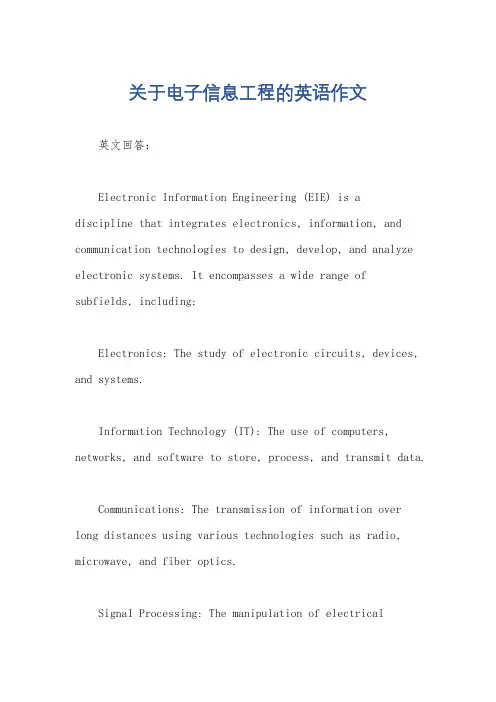
关于电子信息工程的英语作文英文回答:Electronic Information Engineering (EIE) is adiscipline that integrates electronics, information, and communication technologies to design, develop, and analyze electronic systems. It encompasses a wide range of subfields, including:Electronics: The study of electronic circuits, devices, and systems.Information Technology (IT): The use of computers, networks, and software to store, process, and transmit data.Communications: The transmission of information over long distances using various technologies such as radio, microwave, and fiber optics.Signal Processing: The manipulation of electricalsignals to extract useful information or improve their quality.EIE plays a crucial role in modern society, enabling advancements in fields such as telecommunications, healthcare, transportation, and industrial automation.中文回答:电子信息工程。

Structure and function of the smoke alarm series北京联合大学电科1201B Today, fire is a common catastrophic facing the world. It caused a lot of serious damage to human life and property. Fire is one of the disaster threats to public safety and people's life. Many fires are caused by not timely discovery that led to serious consequences. Discovering the fire opportunely play an important role in stop the fire or reduce the loss. For this reason the smoke sensor has been created and it is vital to detect the fire and harmful gases. Because of its unique advantages, the fire alarm on the smoke sensor comes with the requirements. The smoke alarm overcame a lot of uncertainty, which greatly reduces the false alarm rate. There is great value in real life. What constitute the smoke alarm? It mostly combines the six simulations that are ionization smoke sensor, key debug module, AT89C51 module, PC-connectivity, display module and 18B20 temperature sensor.fire When the the is The (1)Ionization smoke sensor used to find mist.will smoke occurs, the ionization sensor can senses then smoke it thetransform the physical signal to the electricity signal and pass the signalto the AT89C51 module.signal the can display (2)The module transform voltage to signal numberthen demonstrate the signal.Display uses the method of dynamic LED digital tube to display. The cost of the dynamic display is very low, but the dynamic display occupies more resources1 / 3of the CPU interface. The design uses 12 lines.(3) The 18B20 temperature sensor senses and controls the temperature.AT89C51 module and PC-connectivity are the staple structure in the system.(4) The Key debug module is like the bridge that link out world and inside system. In other words it is the input system. The user can input the system variable by the key debug module to change the variable in order to achieve aim.In my essay, I introduced the most important structure of the smoke alarm --module and PC-connectivity mostly. AT89C51Firstly, let's acquaint with the microcontrollers. They are the integrated circuitchip that use of VLSI technology to combine the CPU, random access memory, read only memory, a variety of I / O ports and interrupt system to a small but perfect piece of silicon micro-computer system constituted. The microcontrollers widely used in industrial control. From the 1980s ,there are mainly 4-bit or 8-bit microcontroller. With the development of science and technology, it is now the main 300M high-speed microcontroller. The principle of the microcontrollers is an online real-time control of the computer. In other words is on-line control that needs strong anti-jamming capability and low cost. This is the main difference between off-line computers (such as a home PC).Then we can talk about the chips of the microcontrollers. Chips are the coremodel in the microcontrollers. There are many varieties of chips for us to choose, such as STC series, SONIX series, AT89 series、AT90 series and so on. In my system I choose the AT89C51 chip.The AT89C51 is a low-power, high-performance CMOS 8-bit microcontroller with4K bytes of In-System Programmable Flash memory. The device is manufactured using Atm high-density nonvolatile memory technolel'sogy and is compatible with the industry-standard 80C51 instruction set and pinot. The on-chip Flash allows the program memory to be reprogrammed in-system or by a conventionalnonvolatile memory programmer. By combining a versatile 8-bit CPU with In-System Programmable Flash on a monolithic chip, th2 / 3e Atmel AT89C51 is a powerful microcontroller which provides a highly-flexible and cost-effective solution to many embedded control applications.The AT89C51 provides the following standard features: 4K bytes of Flash, 128 bytes of RAM, 32 I/O lines, Watchdog timer, two data pointers, two 16-bit timer/counters, a five-vector two-level interrupt architecture, a full duplex serial port, on-chip oscillator, and clock circuitry. In addition, the AT89C51 is designed with static logic for operation down to zero frequency and supports two software selectable power saving modes.There is my designpicture of module and PC-connectivity module.A T89C51All in all, my essay briefly introducing the smoke alarm that contains the smoke alarm's background of produce, composition, the function of every part. In our life the smoke alarm become more and more important. It exists in our home, school and company. When the danger coming, it will send out alarm to give rise to the danger. We can say that smoke alarm is our fire disaster guardian. I have faith in its development that it can become more advanced and sensitive.3 / 3。
信息科学与电子工程专业英语作文全文共6篇示例,供读者参考篇1Information Science and Electronic Engineering: A Kid's ViewHi there! My name is Emma and I'm 10 years old. Today, I want to tell you all about this really cool thing called Information Science and Electronic Engineering. It's a big fancy name, but it's actually really awesome and fun to learn about!So, what is Information Science and Electronic Engineering? Well, it's basically the study of how we use computers, electronics, and technology to process, store, and share information. It's kind of like how we use our phones, tablets, and computers to send messages, watch videos, play games, and do all sorts of other cool stuff!One of the main parts of Information Science and Electronic Engineering is something called computer science. This is all about how computers work and how we can make them do amazing things. Computer scientists create the software and programs that make our devices work. They also develop things like video games, apps, and websites. How cool is that?Another important part is electronic engineering. This is where people design and build the actual hardware and physical components that make up our computers and other electronic devices. Electronic engineers create things like microchips, circuit boards, and even robots! They have to understand a lot about electricity, physics, and materials to make all these awesome gadgets.Now, you might be thinking, "That sounds really complicated and boring!" But trust me, it's actually super interesting and fun to learn about. There are so many incredible things that Information Science and Electronic Engineering has brought us.For example, did you know that your favorite video games and apps were all created using computer science and electronic engineering? The people who make those games have to know a lot about programming, graphics, and how to make the game run smoothly on different devices. It's like they're modern-day wizards creating these amazing virtual worlds for us to explore!And what about the internet? The internet is basically one huge network of computers and devices all connected together. It's thanks to Information Science and Electronic Engineeringthat we can send messages, watch videos, and access information from anywhere in the world with just a few clicks!But that's not all! Information Science and Electronic Engineering is also helping to make our world a better place. Scientists and engineers are using these technologies to develop things like:Renewable energy sources like solar panels and wind turbinesMedical devices that can help diagnose and treat diseasesRobots that can assist people with disabilities or perform dangerous tasksSystems that can help predict and prepare for natural disastersSee? It's not just about making cool gadgets and games (although those are pretty awesome too). Information Science and Electronic Engineering is also helping to solve real-world problems and make people's lives better.Maybe one day, you could even become an Information Scientist or Electronic Engineer yourself! Just think about how cool it would be to create the next big video game, design a new type of robot, or help build a better, more sustainable world.Well, that's about all I have to say on this topic for now. I hope I was able to give you a better understanding of what Information Science and Electronic Engineering is all about. It's a fascinating field that combines creativity, problem-solving, and a passion for technology. Who knows, maybe you'll be the one to make the next big breakthrough!Thanks for listening, and happy exploring the amazing world of Information Science and Electronic Engineering!篇2Information Science and Electronic Engineering: A World of Wonder!Hi there! My name is Tommy, and I'm an 8-year-old kid who loves learning about science and technology. Today, I want to share with you my thoughts on something called Information Science and Electronic Engineering. It's a big name, but it's all about using computers and electronics to make our lives better!Let me start by telling you about my favorite thing in the world – video games! I love playing them on my console or tablet. Did you know that all those amazing games we enjoy are created by people who study Information Science and Electronic Engineering? They use computers and coding to design thegraphics, sounds, and gameplay that make these games so much fun.But it's not just about games! Information Science and Electronic Engineering also help us in so many other ways. Have you ever used a smartphone or a tablet? Those cool devices are packed with tiny electronic parts that make them work. Engineers design these parts and put them together in a way that lets us take pictures, send messages, and even watch movies on the go!Speaking of movies, did you know that special effects in movies are also created using Information Science and Electronic Engineering? They use computers to make things like explosions, spaceships, and even giant monsters look super realistic. Isn't that amazing?Another thing I find really cool is how Information Science and Electronic Engineering help us communicate with people all over the world. Think about the internet – it's like a giant network that connects computers and devices everywhere. Engineers make sure this network works properly, so we can send emails, watch videos, and even video chat with our friends and family who live far away.But it's not just about fun stuff like games and movies. Information Science and Electronic Engineering also help us in really important ways. For example, doctors use special machines and computers to take pictures of our bodies and diagnose illnesses. Engineers make sure these machines work correctly, so doctors can give us the right treatment.And did you know that even the cars we drive and the planes we fly on have computers and electronic systems inside them? Engineers design these systems to make sure our vehicles are safe and work properly.As you can see, Information Science and Electronic Engineering are all around us, making our lives easier and more exciting. But it's not just about using computers and electronics –it's also about solving problems and coming up with new ideas.Engineers have to think creatively and work hard to design new technologies that can help people in different ways. Maybe one day, they'll even invent a flying car or a robot that can do our homework for us! (Just kidding, but you never know!)Who knows, maybe some of you reading this will grow up to become the next great Information Science and Electronic Engineering experts! You could create the next big video game,design a faster computer, or even help build a rocket that goes to Mars. The possibilities are endless!So, if you love technology and want to make a difference in the world, keep learning and exploring. Ask questions, experiment with coding and electronics, and never stop being curious. The future of Information Science and Electronic Engineering is waiting for you!篇3My Favorite Things to Learn About - Information Science and Electronic Engineering!Hi everyone! My name is Tommy and I'm 9 years old. Today I want to tell you all about my favorite topics to learn about in school - information science and electronic engineering! I find this stuff super fascinating.Let's start with information science. This is all about how we collect, store, and use data and information. In class, we've learned about databases, which are like giant collections of information all stored together. Databases allow you to keep track of lots and lots of data in an organized way.For example, let's say you have a database of all the books in a library. The database would have an entry for each book, with details like the title, author, year it was published, and what section of the library it's located in. With a database, you can easily search for a specific book or books on a certain topic.We've also learned about data mining, which is how you can analyze all the data in a big database to find hidden patterns and trends. It's like being a detective and using clues to crack a case, except the clues are all the data points! Companies use data mining on their customer databases to better understand what people want to buy.Another key part of information science is data visualization. This is how you take data and present it in easy-to-understand visual ways like charts, graphs, and infographics. One of the coolest data viz techniques I've learned about is heat mapping, where you use different colors almost like a weather map to show things like website traffic or prices across a geographic area.Information science is all about turning giant pools of raw data into useful information and insights. Pretty amazing stuff when you think about just how much data exists today between the internet, business records, scientific research, and more!Now let's talk about the other topic I love - electronic engineering. This is figuring out how to design and build all the awesome electronic devices and systems that make the modern world go round.We've covered basic circuits in class, like how a simple circuit has a power source like a battery that provides the energy to make electrons flow through a conductor like a metal wire. By adding other components like switches, resistors, and lightbulbs, you can control and manipulate that flow of electricity to do useful things.From there, we've built up to more complex circuits using transistors, which are like solid-state switches that can amplify or transform electrical signals. Transistors are one of the fundamental building blocks of all modern electronics and computing. Billions of teeny tiny transistors are crammed into the microchips that act as the "brains" of smartphones, computers, and so much more.In addition to circuits and microchips, we've learned about other electronic devices and components like capacitors for storing electric charge, transformers for increasing or decreasing voltage, and all sorts of sensors for detecting things like light,sound, and motion. We even built our own basic robots by wiring up little motors and sensors to a microcontroller chip!Another amazing area of electronic engineering is communications systems - things like radio, television, internet, and wireless data networks. We learned how data can be encoded into electromagnetic waves and transmitted through the air, along cables, or via fiber optic lines. Multiplexing techniques allow tons of separate signals and channels to be combined together and transmitted simultaneously.On the receiving end, devices like radios and modems decode the incoming signals to recover the original data. Routers, switches, and other networking gear help route the data to its intended destination. Just think about how much electronic wizardry has to happen for you to simple send a text message or stream a video!My absolute favorite part of electronic engineering is imagining and designing all the cool future technologies that will one day exist. Technologies like laser-powered data transmission, quantum computers, and lifelike robotics and artificial intelligence seem like total science fiction now. But I can't wait to see what incredible new electronic marvels get invented as scientists and engineers keep pushing the boundaries.Well, that's my overview of why I find information science and electronic engineering so amazing. At their core, both fields are all about harnessing data and electricity to create powerful tools and technologies that can reshape how we live and understand the world around us. Just imagining where these disciplines will go next gets me incredibly excited!I have so much more to learn, but I feel like I'm getting a great foundation. Who knows, in 20 years I may be the one helping design quantum computer microchips or developing new data mining techniques to analyze zettabytes of information! For now though, I better get back to studying. This stuff is just endlessly fascinating to me. Thanks for reading, talk to you later!篇4My Big Sister Is An EngineerI love my big sister Emily! She's the coolest and smartest person I know. Emily is studying to be an engineer at university. At first, I didn't really understand what that meant, but now I think it's super awesome!Emily studies something called "Information Science and Electronic Engineering." That's a really long name, but she explained it to me in a way I could understand. You see,engineers are like modern-day wizards who use science and math to create amazing things that make our lives easier and more fun!Information Science is all about computers, the internet, and how we share and use information. Emily learns how to build websites, write computer programs, and keep our data safe from bad guys trying to steal it. Can you imagine a world without computers or the internet? I can't! It would be so boring.The Electronic Engineering part is even cooler. Emily gets to learn about electricity, circuits, and all the cool gadgets we use every day, like smartphones, TVs, and video game consoles. She knows how they work and can even build her own!One time, Emily let me visit her university lab, and it was like stepping into a magical workshop. There were tables filled with tiny electronic components, circuit boards, and tools I'd never seen before. Emily showed me a little robot she had built from scratch, and it could move around and follow simple commands.I thought that was the coolest thing ever!But being an engineer isn't just about building robots and gadgets. Emily also learns about communication systems, like how our voices travel through phone lines or how we can sendpictures and videos over the internet in seconds. It's like having a superpower!Emily says that engineers have to be good at math, science, and problem-solving. They have to think logically and creatively to find solutions to all kinds of problems. Sometimes, she has to work on projects with her classmates, which teaches her how to collaborate and communicate well with others.One of the things I admire most about Emily is how hard she works. She spends hours studying, doing homework, and working on projects. But she doesn't seem to mind because she's so passionate about what she's learning. She says that every day is an opportunity to discover something new and exciting.I can't wait until Emily graduates and gets a job as an engineer. Who knows, maybe she'll design the next big video game console or help build a rocket that takes people to Mars! The possibilities are endless when you're an engineer.Sometimes, when I'm playing with my Lego sets or trying to figure out a puzzle, I imagine myself as an engineer like Emily. I pretend that I'm building a giant robot or designing a new kind of computer. It's so much fun to let my imagination run wild and think about all the amazing things I could create someday.Emily says that the world needs more engineers to help solve problems and make life better for everyone. She always encourages me to study hard, especially in math and science, because those subjects will help me become a great engineer too if I want.I'm not sure yet if I want to be an engineer when I grow up, but I know that whatever I choose to do, I want to be just like my big sister Emily – smart, creative, hardworking, and always eager to learn new things.For now, I'll keep playing with my Legos, tinkering with my toys, and dreaming big dreams. Who knows, maybe one day I'll be the one building amazing robots or designing the next generation of computers and gadgets. With an engineer like Emily as my role model, anything seems possible!篇5My Big Sister's Awesome JobHi there! My name is Tommy, and I'm eight years old. I want to tell you all about my big sister Sarah and her really cool job. She's an Information Science and Electronic Engineering professional, which sounds super fancy and complicated, but I'lldo my best to explain it in a way that even a kid like me can understand.Sarah works with computers and electronics, which are like magic boxes that can do all sorts of amazing things. She helps make them work better, faster, and smarter. Isn't that awesome? Sometimes, she even gets to build new gadgets and gizmos from scratch!One of the things Sarah does is something called "coding." Now, I know what you're thinking – "Coding? That sounds boring!" But trust me, it's actually really exciting. Coding is like giving instructions to computers, sort of like telling your dog to sit or roll over, but way more complicated. Sarah uses special languages (not like French or Spanish, but like computer languages) to tell the machines what to do.For example, she might tell a computer to sort through a bunch of data and find specific information, or to control a robot arm in a factory. It's like she's a master magician, waving her wand (which is actually a keyboard) and making the computers do whatever she wants!Another part of Sarah's job is something called "hardware engineering." This means she gets to design and build the physical parts of computers and other electronic devices. It's likebeing a super-cool construction worker, but instead of building houses, she builds tiny little cities inside the machines!Sarah has shown me some of the gadgets she's worked on, and let me tell you, they're mind-blowing. There was this one thing that looked like a regular old box, but it could actually control the lights and temperature in our house just by talking to it. How crazy is that?But Sarah's job isn't just about coding and building stuff. She also has to solve lots of problems and figure out how to make things work better. Sometimes, things go wrong with computers or electronics, and it's her job to figure out what's causing the issue and fix it. It's like being a detective, but instead of looking for clues at a crime scene, she's investigating the inner workings of machines.Sarah says that one of the best parts of her job is getting to work with other really smart people. She's part of a team, and they all collaborate to come up with new ideas and solutions. It's like having a whole group of super-genius friends who all love computers and electronics as much as she does.Now, you might be thinking, "Wow, that sounds like a lot of hard work!" And you'd be right. Sarah has to study and learn new things all the time, and she often has to work late nights orweekends to meet deadlines. But she says it's all worth it because she loves what she does.You see, Sarah has always been fascinated by technology and how things work. When she was little, she used to take apart her toys and put them back together again (sometimes they even worked after!). She was always asking questions and trying to figure out how things worked.So, when it came time to choose a career, Information Science and Electronic Engineering was the perfect fit for her. She gets to work with the latest and greatest technology, and she's constantly learning and growing.Honestly, I'm still not entirely sure what Sarah does every day at her job, but I know it's something really important and exciting. And who knows, maybe one day I'll follow in her footsteps and become an Information Science and Electronic Engineering professional too!For now, though, I'm content to just listen to Sarah's stories and play with the cool gadgets she brings home from work. I might not understand all the technical details, but I know that my big sister has one of the coolest jobs in the world. And that's something to be proud of!篇6My Big Dream of Becoming an Awesome EngineerHi there! My name is Timmy and I'm 10 years old. I just finished 4th grade and can't wait for summer vacation! You know what I really love? I love science and building things. That's why I dream of becoming an amazing engineer when I grow up.Engineering is just the coolest thing ever. Do you know what engineers do? They get to design and create all sorts of awesome machines, robots, computers, phones, and other crazy gadgets! How awesome is that? Way better than being a boring teacher or accountant if you ask me.There are different types of engineers too. Information science engineers are like the brains behind all the technology we use every day. They design the software and programs that make our phones, laptops, and video games work. Without them, our devices would be basically just hunks of plastic and metal. Boring!Then you have electronic engineers who design the actual electronics and hardware inside our gadgets. They get to build circuit boards, processors, and all the tiny components that makeeverything run. It's like they get to play with ultra-tiny building blocks and wires all day long. So fun!I can't decide if I want to be an information science engineer or electronic engineer when I grow up. Maybe I'll do both! I'll design the software AND the electronics. Then I can create the whole product from scratch - nothing could stop me!Just imagine if I designed the next big gaming console or smart phone. I'd put in a blazing fast processor, tons of memory, and high-def graphics that would blow your mind. And I'd code all the games and apps too so you'd never get bored. It would be the hottest device ever and all the kids would beg their parents for one. I'd be rich AND famous!Or maybe I'll design robots instead. Not lame little robots that just vacuum, but awesome robots that can talk, play sports, or even fight crime. I'd make them super strong but also program them with artificial intelligence to be really smart. My robot squad could handle any problem or rescue any person in need. We'd be like a team of robotic superheroes protecting the world!Heck, if I'm really ambitious, I could even engineer entire cities of the future. Self-driving car systems, renewable energy grids, ultra-fast communication networks - I'd design it all. Thecities would basically run themselves with minimal human effort required. Everyone would live in modern, efficient luxury thanks to my brilliant engineering.Whoa, sorry, I got a little carried away dreaming there. Sometimes my big imagination gets the best of me. But isn't it crazy all the potential that engineers have? With their skills and knowledge, they can literally design our future world. That's why I'm going to study my butt off in math, science, and technology so I can grow up to be one.I may only be in elementary school now, but I'm already tinkering with electronics and coding as much as I can. My parents got me a basic robotics kit and I've been building simple rovers and robotic arms. I've also been teaching myself coding by making basic games and messing around on coding websites. It's never too early to start prepping to become an engineering prodigy!My friends think I'm a little weird always playing with circuits and computers instead of going outside. But who cares? I have huge plans that involve much more than just running around at the park all day. With hard work and perseverance, I'll get through all the tough engineering classes in college. Then I'llland my dream job designing the latest must-have technologies alongside other geniuses. We'll change the world together!Just you wait and see. In a couple decades, I may have engineered crazy holographic smartphones, sentient robot assistants, or self-sustaining colonies on Mars. The possibilities are endless because I'm going to be an engineering master of the future! Maybe you'll see my name in headlines or I'll become a legendary tech billionaire. Or maybe I'll just be quietly working behind the scenes, dreaming up must-have gadgets from my Silicon Valley lab. Whichever path I take, the world better brace itself for the insane creations of Timmy the Engineer!So yeah, that's my huge, epic dream career. What's your dream? Astronaut? Artist? Veterinarian? Whatever it is, just never stop dreaming big! Study hard, stay focused, and amazing things can happen, just like my coming engineering awesomeness. Okay, gotta go - I need to put some finishing touches on theAI-powered robotic puppy。
专业英语复习Lesson3Microprocessors (1)Lesson4Operational Amplifiers (2)Lesson8Clock Sources (3)Lesson12Personal Computer Systems (4)Lesson13Overview of Modern Digital Design (5)Lesson16Basic Concepts of DSP (6)Lesson19High Fidelity Audio (8)Lesson22Digital Image Fundamentals (9)Lesson25Choosing the right core (10)Lesson26Design Languages for Embedded Systems (11)Lesson27Choosing a Real-Time Operating System (12)Lesson28Signal Sources (13)Lesson3Microprocessors1.micron是“微米(百万分之一米)”2.data width是指算术逻辑单元ALU的字长3.MIPS Million Instructions Per Second每秒百万条指令4.Reset复位5.tri-state buffer三态缓冲器A tri-state buffer is a device that allows you to control when an output signal makes it to the bus.When the tri-state buffer's control bit is active,the input of the device makes it to the output.When it's not active,the output of the device is Z,which is high-impedance or,equivalently,nothing.There is no electrical signal is allowed to pass to the output.6.PipeliningA technique where the microprocessor fetches the next instruction before completing execution of the previous instruction,in order to increase processing speed.)流水线是一种在前一条指令全部执行完之前就开始取下一条指令,以提高处理速度的技术。
鲁东大学信息与电气工程学院2015 -2016 学年第-----2----学期《 专业英语 》课程论文 课程号: 220821071任课教师 贾世祥 成绩论文题目:专业科技论文翻译对给定的发表在正规外文期刊上的电子信息类专业科技论文进行翻译,包含Title 、Introduction 、Algorithm 、Result 、Discussion 、Reference 等内容。
论文要求:(对论文题目、内容、行文、字数等作出判分规定。
)1.论文格式参考学院学士毕业论文要求,要有题目、摘要、关键字、正文、参考文献。
2.原文不包含摘要和关键字,请阅读原文并写出200~300字的英文摘要,给出5个英文关键字。
3.语言表达流畅,涉及到的图表字迹清晰,公式使用公式编辑器编辑。
4.设计报告使用B4纸打印,正文的图表可黑白打印。
教师评语:教师签字: 年 月 日一个简单、快速、有效的多边形减面算法Stan MelaxAbstract :This article describes a new type of 3D model to optimize the reduction surface algorithm. Previousalgorithms although it can reduce operating surface, but it in the reduction process will generate a lot of only makes processing speed becomes slow excess facet. This new algorithm is mainly through the edge collapse operation toachieve the effect of reducing the surface. This paper explains the characteristics and advantages of this algorithm by means of examples. The advantages and disadvantages of the new algorithm are also analyzed. Our initial goal is simple: we want to find a method can be reduced due to excessive blasting effects of polygons, now our art personnel only need to create a detailed model for every game objects. But there are limitations, this algorithm can only be applied to thetriangle, if you need to be able to other more edges of the polygon into a simple triangle, in addition to this there is no other restrictions on the.Keywords :Polygon reduction;Edge Collapse ;Pretreatment ;Optimization model ;Optimization model; Application algorithm ;如果你是一个游戏开发者,那么3D 多边形模型非常有可能是日常生活中的一部分,而且你对多少个多边形每秒、少多边形建模、细节层次等概念非常熟悉。
你可能知道多边形减面算法的目的在于通过一个有着大量多边形的高细节的模型生成一个多边形数量比它少、但是看起来却跟原模型很相像的低面模型。
这篇文章解释了一种实现自动减面的方法,并且附带的讨论了多边形减面的有用之处。
在我们开始之前,我建议你去下载我的一个程序:BUNNYLOD.EXE ,它展示了我将要阐述的这项技术。
你可以在Game Develop 网站上找到它。
问题的由来在深入这个很厉害的3D 算法之前,你可能会问你自己真的有必要关注它吗?要知道,已经有一些商业的插件和工具来为你减少多边形数量了。
然而,下面的几条理由会告诉你为什么需要实现自己的减面算法:学院 信息与电气工程学院 专业 信息工程 班级 信息1301班 本学号 20132213652 20132213664 姓名 李惠梁 吴海峰● 你使用的多边形减面工具生成的结果无法满足你的特殊需求,因此你希望做一个自己的工具。
● 你当前使用的多边形减面工具可能无法产生减面过程中的变化信息,而你却希望利用这些变化信息来使不同的细节层次之间的转换更加平滑。
● 你希望将生产过程自动化,这样的话美术人员就仅仅需要创建一个细节适当的模型,然后游戏引擎就能自动创建模型其余的细节层次。
● 你正在制作一个VRML 浏览器,你希望提供一个菜单项来简化那些巨大的VRML 文件。
那些把这些巨大的文件放到网上的超级计算机用户没有想到这些文件在普通家用电脑上显示帧速率会比较低。
● 你在你的游戏中使用的特效改变了物体的几何形状,增加了多边形的数量,你需要一个方法来使你的引擎能够实时地快速减少多边形数量。
你对此怀疑?图1展示了一个具体的实例,一个游戏引擎对减少多边形这种特性的需求。
图1 爆炸效果对多边形数量的影响在Bioware ,我实现了实时的爆炸效果,并且把它们应用在了我们开发的一个游戏原型上,以便给我们的出版商留下深刻印象。
玩家可以射击和爆破他们瞄准的实心物体表面的任意块。
通过子弹撞击而改变游戏环境比典型的“定点爆破”这种只能在游戏世界中改变预先设定项的技术更棒。
遗憾的是,重复不断的使用爆破效果会在物体上产生大量附加的三角形,如同你在图1中看到的一样。
许多添加的面是很小的或者是碎片,不会对游戏的视觉效果产生丝毫的影响——它们仅仅是让游戏更慢。
这种情况下就要求有实时的多边形减面功能,所以我开始寻找一种能够高效地完成这项工作的算法。
坍塌边图2 边塌陷在我着手处理这个问题之前,我跟亚伯达大学图形实验室的一些人学习了多边形减面。
(它让我跟一个团队一起工作,从而弄明白这个非常难的算法是如何工作的,并且弄明白什么样的技术适用于什么样的任务。
)最近这个领域出现了很多研究成果,但其中大多数比较好的技术都是 H.Hpppe 的渐进网格算法的改进和变形(参见“更多的信息”)。
那些技术都是通过重复不断的使用一个简单的边坍塌操作来降低模型的复杂度。
在这个操作里面,u和v两个顶点(边uv)被选中并且其中一个顶点(这里是u)“移动”或者说“坍塌”到另一个顶点(这个例子里是v)。
下面这些步骤说明如何实现这个操作:1. 去除所有既包含顶点u又包含顶点v的三角形(换一种说法,去除所有以uv为边的三角形)。
2. 更新所有剩下的三角形,把所有用到顶点u的地方都用顶点v代替。
3. 移除顶点u。
重复以上的过程,直到多边形的数量达到了预期数量。
每一次重复的过程中,通常会移除一个顶点、两个面、三条边。
图3展示了一个简单的例子。
图2 边塌陷选择下一条边进行坍塌要产生效果比较好的底面模型的诀窍在于要正确地选择坍塌的边,能够在坍塌的时候最小程度的影响模型的视觉变化。
研究者提出了各种各样的方法来使在每一次坍塌的时候能够选择出“最小影响”的边。
但遗憾的是,最好的那种方法非常非常复杂(也就是说,很难实现),并且要花大量时间用于运算。
因此这推动我要找到一种能够在游戏运行阶段减少多边形面数的方法,我做了很多实验,最后终于为这个选择边的过程开发了一种简单又超快的方法来生成相当不错的低面模型。
显然,先要去除那些小细节。
同时要注意的是,对于那些在同一平面上的表面,只需要很少的多边形就可以表示,同时高度弯曲的曲面则需要更多的多边形来表示。
根据以上这些,我们定义了:一条边是否要坍塌,取决于它的边长与曲率值的乘积。
为了找到在uv方向上距离别的三角形最远的u的临接三角形,我们通过比较两个面的法线的点积得到坍塌边uv的曲率值。
方程式1展现了用更多正式符号表示的求边坍塌值的公式。
详见源码(你可以在Game Developer网站上下载到源代码)。
Tu是包含顶点u的三角形的集合,Tuv是同时包含顶点u和顶点v的三角形的集合。
方程式1 求边坍塌值的方程式你可以看到,这个算法在决定哪一条边坍塌的时候对于面的曲率和大小做了平衡。
要注意的是顶点u到v的坍塌值不一定和顶点v到u的坍塌值相同。
此外,这个公式对于脊状的边的坍塌也是有效的。
即使这条脊有可能是一个锐角,或者是直角,都没有关系。
图4举例说明了这种情况。
非常明显的,在平面区域中间的顶点B,可以被坍塌到顶点A或者顶点C。
角上的顶点C应该最后被保留下来。
如果把上面的顶点A坍塌到内部的顶点B,那就会非常糟糕。
不过,顶点A可以沿着脊坍塌到顶点C,这丝毫不会影响这个模型的外观。
图4 好的和差的边坍塌如果你正在实作你自己的减面算法,你可能希望能够用这个公式做实验,来看看是否满足你的要求。
例如,对于一个动画模型,你可能希望能够改进公式,使它能够在判断潜在的坍塌边的时候可以参考不止一个动画关键帧的数据。
如果对于你来说,模型质量比减面算法所需要的执行时间更重要的话,你应该考虑使用Hoppe 的函数。
我们已经添加了很多扩展用来处理贴图坐标、顶点法线、邻接边,以及表面断裂(比如贴图接缝)。
结果先显示一个原来的模型,然后显示简化后的模型,这是对多边形减面算法效果的最好证明。
大多数的研究论文都用非常高面高细节的模型减面来证明它们的效果,原始模型接近100,000个多边形,简化后的模型只有10,000个多边形。
对于3D 游戏来说,更恰当(并且跟有挑战性)的测试是生成一个只有几百个多边形的模型,以此展示算法的强大威力。
图5 453个、200个以及100个顶点的小兔子模型(从左到右)图6 随机选择坍塌边(200个顶点)举个例子,图5展示了一个小兔子的模型,它是从一个由 Viewpoint Datalabs 制作的VRML文件中提取出来的。
模型的最初版本(左边)包含有453个顶点和902个多边形。
后边显示的是减少到200个顶点(中间)和100个顶点(右边)的模型。
希望你能够对图中不同数量多边形模型的视觉外观看起来感到满意。
图6展示了由于没有选择出正确的坍塌边而简化的模型,这里坍塌边的选择是随机的。
图7 一个女性的人物模型,左边100%多边形数量,中间20%多边形数量,右边是4%多边形数量当我们完成了动物实验之后,就要开始把这种算法应用在人物模型上了。